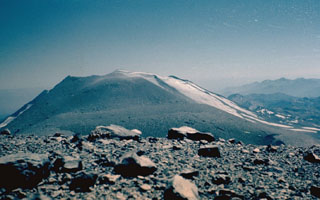Report on Nevados de Chillan (Chile) — 17 November-23 November 2021
Smithsonian Institution / US Geological Survey
Weekly Volcanic Activity Report, 17 November-23 November 2021
Managing Editor: Sally Sennert.
Please cite this report as:
Global Volcanism Program, 2021. Report on Nevados de Chillan (Chile) (Sennert, S, ed.). Weekly Volcanic Activity Report, 17 November-23 November 2021. Smithsonian Institution and US Geological Survey.
Nevados de Chillan
Chile
36.868°S, 71.378°W; summit elev. 3180 m
All times are local (unless otherwise noted)
SERNAGEOMIN reported continuing explosive and effusive activity at Nevados de Chillán’s Nicanor Crater during 1-15 November. Explosions generated both plumes with moderate ash content and white steam-rich plumes that rose as high as 2 km above the crater rim. Explosions occasionally ejected incandescent material onto the N side of the crater and the N flank.
A new dome, which had emerged around 28 October at the L7 vent, was partially destroyed by explosions on 8 November, and then regrew to 80 m long and 55 m wide. Pyroclastic flows descended the NE flank, traveling as far as 700 m on 8 and 10 November. The L7 lava flow, between the inactive L5 and L6 flows, slowly advanced and was 930 m long; a NE branch of L7 had not advanced since 14 October, though SE and E branches formed on 9 and 14 November, respectively. A second active flow, L8, had not lengthened past 385 m. Sulfur dioxide emissions averaged 300 tons per day, peaking at 462 tons per day on 14 November, and were lower than rates recorded during the last half of September. The Alert Level remained at Yellow, the second lowest level on a four-color scale. ONEMI stated that Alert Level Yellow (the middle level on a three-color scale) remained in place for the communities of Pinto and Coihueco, noting that the public should stay at least 2 km away from the crater.
Geological Summary. The compound volcano of Nevados de Chillán is one of the most active of the Central Andes. Three late-Pleistocene to Holocene stratovolcanoes were constructed along a NNW-SSE line within three nested Pleistocene calderas, which produced ignimbrite sheets extending more than 100 km into the Central Depression of Chile. The dominantly andesitic Cerro Blanco (Volcán Nevado) stratovolcano is located at the NW end of the massif. Volcán Viejo (Volcán Chillán), which was the main active vent during the 17th-19th centuries, occupies the SE end. The Volcán Nuevo lava-dome complex formed during 1906-1945 on the NW flank of Viejo. The Volcán Arrau dome complex was then constructed on the SE side of Volcán Nuevo between 1973 and 1986, and eventually exceeded its height. Smaller domes or cones are present in the 5-km valley between the two major edifices.
Sources: Servicio Nacional de Geología y Minería (SERNAGEOMIN), Oficina Nacional de Emergencia-Ministerio del Interior (ONEMI)

